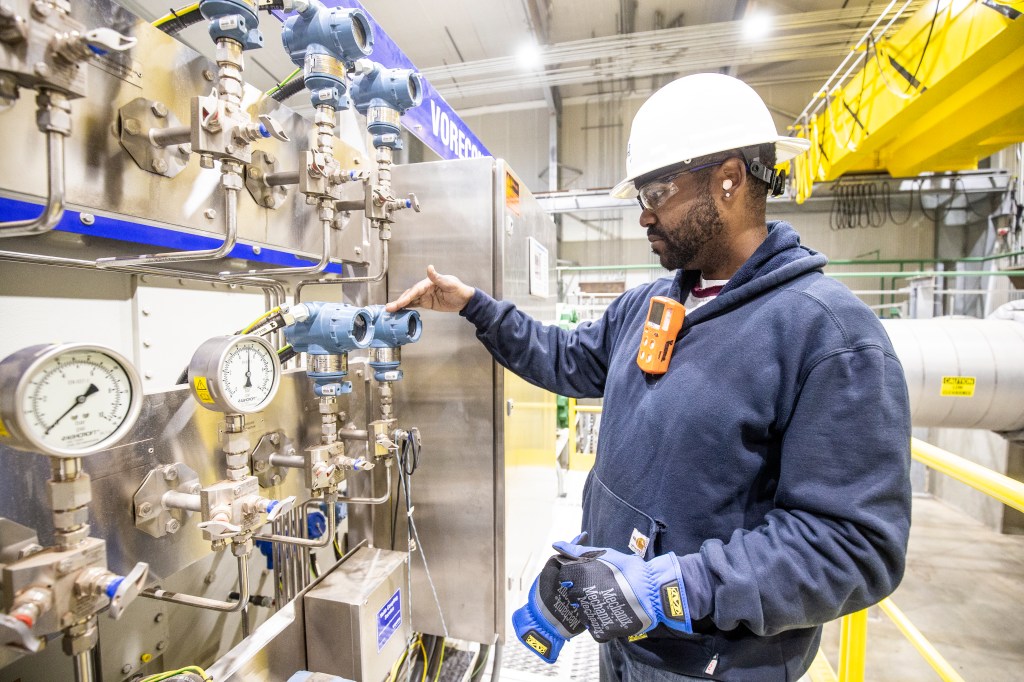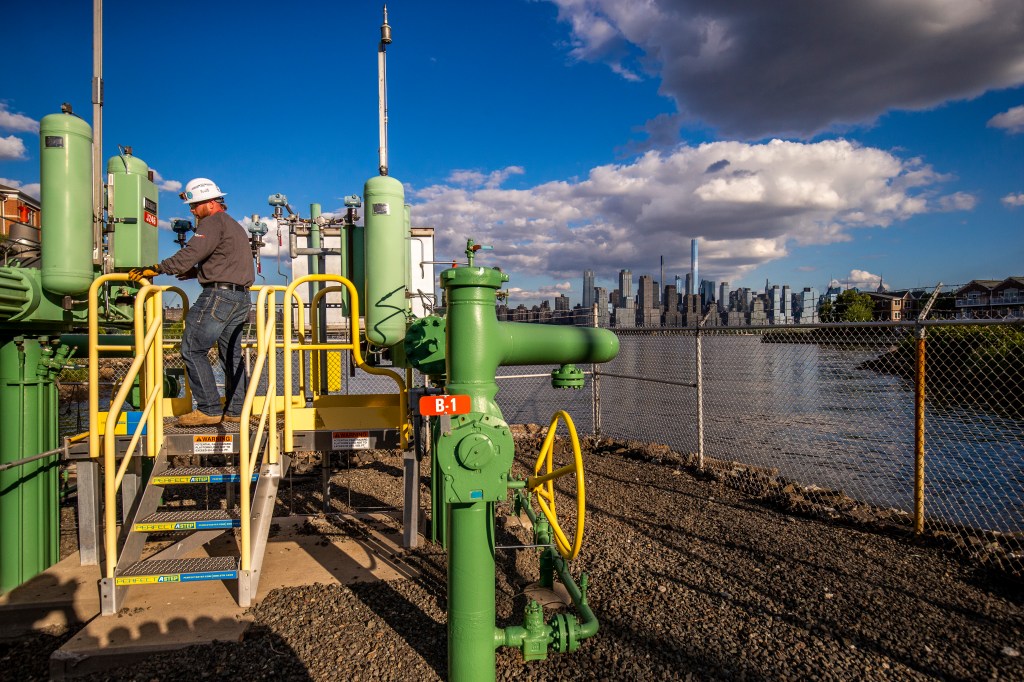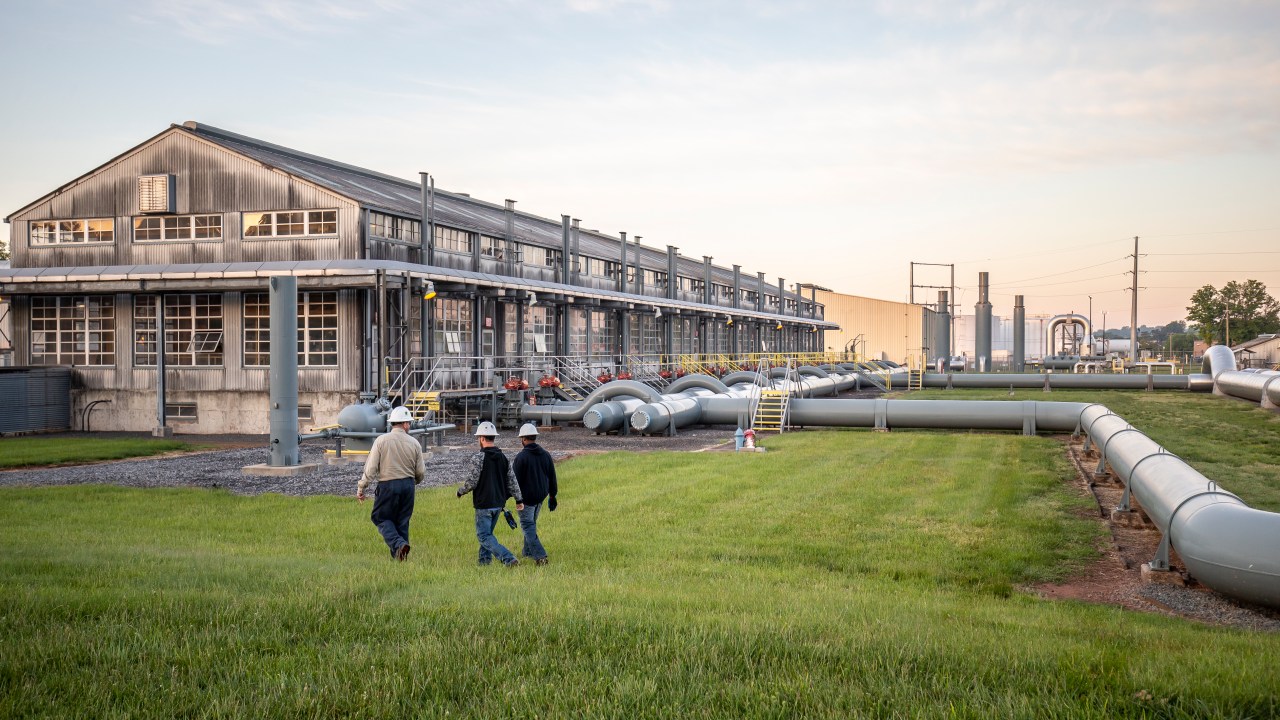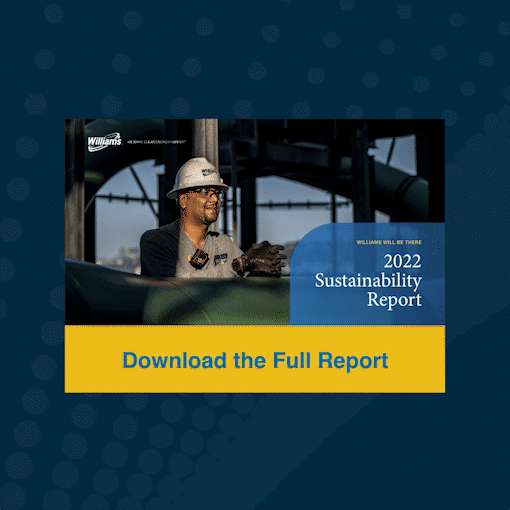Why This Matters to Williams
Williams takes pride in supporting the delivery of clean, reliable energy to thousands of communities across the U.S., helping to improve quality of life by providing products and services that enable homes and businesses to obtain heat and power. We recognize that the assets we operate and the products we transport generate greenhouse gas (GHG) emissions directly from our operations and indirectly from our electricity consumption. As one of the largest midstream operators in the country, we must effectively monitor, report and reduce our Scope 1 and 2 emissions to minimize the climate impacts of our operations while continuing to meet the growing demand for safe, dependable energy. Williams is continuing our efforts to reduce GHG emissions through operating efficiencies, investing in upgrading and modernizing equipment and leveraging clean energy technologies.
GHG Quantification, Monitoring & Transparent Reporting
Transparent communication about our GHG performance remains an important expectation of our stakeholders. We prioritize accurately tracking and reporting our GHG emissions using robust data collection methods. The Williams Integrated Management System (WIMS) houses our protocols for monitoring GHG emissions and complying with federal and state reporting requirements. Williams continues to refine our GHG emissions detection and quantification through advanced measurement technologies and enhanced calculation practices.
We monitor emissions down to the facility level using a robust GHG emissions dashboard. The dashboard tracks emissions for each Williams compressor station, processing plant and fractionator, regardless of whether it meets reporting thresholds required by regulation. Our subject matter experts, engineering groups, environmental specialists and operations personnel use GHG emissions data to develop emissions reduction strategies. Thus, Williams aims to report GHG data in a timely and actionable manner so that these parties may effectively drive down emissions, create operational efficiencies and reduce costs. In 2022, we successfully expanded the use of operational data from fuel meters at some of our processing plants to more accurately calculate emissions at these plants. We introduced these more accurate calculation procedures at some of our gathering compressor stations last year and in 2022, we expanded them to our processing plants, which further reduced reported emissions by an estimated 107,151 metric tons of CO2e.
Each year, we prepare and submit a GHG emissions inventory to the U.S. Environmental Protection Agency (EPA) for our midstream gathering, processing and interstate transmission and storage operations. We also collect, quantify, and disclose Scope 1 and 2 emissions data in accordance with ONE Future and CDP technical guidance.
Since 2019, Williams has engaged ERM Certification and Verification Services (ERM CVS) to provide third-party verification of the following GHG emissions data: total absolute Scope 1 GHG emissions, total location-based Scope 2 GHG emissions and total Scope 1 and 2 GHG emissions. Since 2021, ERM CVS has also provided verification of Williams’ methane emissions data. ERM CVS provided assurance that the GHG data reported in the graph below were fairly presented in all material respects. Please see our full Assurance Report on page 136 of our PDF report.

GHG Emissions Reduction Targets & Progress
Williams’ 2030 target of a 56% reduction in Scope 1 and 2 emissions from a 2005 baseline reflects our commitment to reducing GHG emissions in a time frame that holds our leadership accountable. We set this target in recognition of the progress we have already made and the reduction opportunities we see ahead. Our 2005 baseline aligns with the baseline of the U.S. climate goal established under the Paris Agreement. We consider this reduction target in our decision-making around capital and resource allocation, and we have made significant progress toward this target even as our gathering, processing, and transmission throughputs have risen. Additionally, the acquisition of Trace Midstream and NorTex Midstream in 2022 bolsters the company’s ability to connect low-emissions natural gas supplies to areas of expanding demand. The acquisition of these assets, along with transmission operational enhancements, resulted in Williams’ experiencing a slight absolute operational emissions increase in 2022. We are excited to bring Williams’ leading emissions reduction practices, technology investments, and commitments to both new and existing assets. Since 2005, we have reduced our operational emissions by 43% and remain on track to meet our 2030 goal.
In addition to pursuing reductions in absolute GHG emissions, Williams continues to decrease our emissions intensity, which measures GHG emissions per unit of natural gas throughput. Even though we continue to expand our footprint, targeted improvements in practices and technology have enabled us to decrease our emissions intensity by 16.5% since 2018. This achievement highlights Williams’ role as a responsible energy operator that is best equipped to deliver clean, affordable and reliable energy.
We continuously work to reduce our operational GHG emissions, especially methane emissions, by operating our assets as efficiently as possible. Our assets primarily include gathering systems, intrastate and interstate transmission pipelines, compressor stations, natural gas processing plants and liquefied natural gas (LNG) and underground storage facilities. We reduce emissions from these assets through preventive maintenance, installing emissions reduction equipment such as compressor vent gas reduction systems and emission control devices, conducting leak detection and repair (LDAR) events, implementing recompression measures and installing or replacing gas drivers with electric motors where practical.
Leak Detection & Repair
Williams continuously strives to minimize methane leaks from our natural gas gathering and processing and transmission operations. To identify and repair leaking equipment, we conduct quarterly, semiannual or annual LDAR surveys on Williams’ compressor stations and facilities using an optical gas imaging (OGI) camera. Surveys conducted through Williams’ Leak Detection and Repair Program (WilLDAR) are an effective work practice to significantly reduce fugitive methane emissions to the environment. In 2022, through the WilLDAR program, we performed leak surveys using OGI at 43 Transco and Northwest Pipeline compressor stations that did not previously have LDAR required by state or federal regulations. By implementing WilLDAR and achieving quicker recognition of repaired leaks using quarterly surveys, reported equipment component emissions at transmission compressor stations decreased by an estimated 25% from 2021 to 2022.
Williams has developed separate LDAR Standards for our gathering, boosting and transmission segments and is developing a comprehensive requirement within our integrated management system that outlines roles and responsibilities for LDAR. Once completed, we will use these documents to communicate the roles and responsibilities of Williams employees for promoting an improved, efficient and effective LDAR program across the enterprise.
Williams also uses a single software platform, Leak Tracker Pro™ (LTP), to maintain leak records from OGI surveys conducted in the Williams gathering, boosting and transmission sectors. LTP accurately identifies leaking equipment components such as valves, connectors, flanges, pumps and open-ended lines, enabling operators to make the necessary repairs. Williams analyzes LTP results to identify recurring failing equipment to guide maintenance practices and equipment purchases in an effort to reduce future leaks at our facilities, helping to achieve our emissions reduction targets. By reducing equipment failure and leaks, Williams further enhances operational reliability and reduces maintenance costs.

GHG Reduction Initiatives & Opportunities
Williams continues to invest in GHG reduction initiatives across our operations. To inform our emission reduction investments and maximize impact in 2022, Williams subscribed to new technologies, including Context Labs, Orbital Sidekick, Encino Environmental and LongPath Technologies, to help identify sources of emissions in real-time. Context Labs Decarbonization as a Service (DaaS™) platform collects data from operations, satellite emissions monitoring, continuous emissions monitoring and ongoing leak detection activity to identify and prioritize operational response and emission reduction opportunities.
In 2022, our emission reduction efforts included upgrading compressor stations, testing hydrogen fuel blends in reciprocating compressor engines, evaluating increased and indefinite pressurized hold during compressor downtime, replacing high-bleed pneumatic devices with low- or no-bleed devices and installing dry seal gas capture systems at some compressor stations. Williams also piloted our PAGER system (patent pending), designed to recover and combust pigging emissions via catalytic heater, within our Wetzell Gas Gathering System and Ohio River Supply Hub.
Also in 2022, Williams developed new guidance on reducing emissions during pipeline purging activities and implemented the guidance into our existing operating procedures. For example, when purging pipelines that are being returned to service, we began targeting reduced purge pressures and reduced extended purge hold times. Our senior leaders shared guidance with operations and project execution to reinforce the importance of responsibly managing pipeline purging activities.
Williams continues to proactively reduce emissions from transmission pipeline blowdowns. In 2022, our employees formed a pipeline maintenance emissions reduction work group, supported by senior leadership, focused on improving large pipeline blowdowns and providing resources to project managers to streamline the emissions reduction planning process. The work group creates blowdown optimization tools, develops work practices and onboards new mobile compression and flaring vendors.
We follow operating procedures that use pressure draw down and recompression measures to lower gas line pressure before pipeline maintenance. In 2022, Williams reported 48 separate blowdown events in which natural gas was rerouted or captured and recompressed instead of being vented. In doing so, Williams saved 0.9 billion cubic feet of gas, the equivalent of heating more than 21,692 homes for a year.
Total company Scope 1 and 2 emissions in metric tons of CO2e from gathering, processing and transmission segments divided by the sum of natural gas (in MMscf) transported in all three segments.
Maintaining strong customer relationships is essential to reducing emissions from maintenance events that may prompt a pipeline blowdown. Therefore, we work alongside our customers to determine mutually beneficial solutions to minimize emissions, enhance reliability and strengthen collaboration. In 2022, our efforts to improve pipeline blowdown procedures prevented an estimated 347,136 metric tons of CO2e emissions.
We plan to continue to expand our carbon reduction opportunities while looking to invest in future clean energy projects and carbon abatement instruments. By cost-effectively reducing GHG emissions, we are contributing to the total reductions necessary to achieve our 2030 target. For more information on our climate commitment, see our website.
The path to achieving our long-term aspiration of being net zero by 2050 focuses on leveraging current and emerging technologies to reduce emissions and provide necessary reliability for scaling renewable energy to help fuel the clean energy economy, all while prioritizing our natural gas-focused business strategy. We are proactively advancing this strategy with the expertise of Williams’ New Energy Ventures group. The group focuses on commercializing innovative technologies and markets that will ultimately contribute to attainment of our climate commitments. For more information on our New Energy Ventures group, please refer to the Energy Transition & Low-Carbon Economy section.
Our partnership with Williams and Coterra is another important step in reducing emissions across the entire natural gas value chain. Certified, low-emissions natural gas is a vital part of achieving our goal of net zero greenhouse gas emissions by 2050. We look forward to continuing this and other innovative partnerships to deliver affordable, reliable and clean energy to the customers we serve.
CEDRIC GREEN, SENIOR VICE PRESIDENT OF POWER GENERATION FOR DOMINION ENERGY VIRGINIA
WILLIAMS WILL BE THERE
Advancing NextGen Gas
Williams is excited to have established the first low-emissions, NextGen Gas certification process that can cover the entire natural gas value chain from production through gathering and transmission. To make this possible, Williams entered into an agreement with upstream producer Coterra Energy and downstream utility Dominion Energy Virginia to provide a full value chain, low emission solution. The agreement with Coterra Energy and Dominion Energy builds on Williams’ strategy to provide a path-specific methane intensity certification that meets or exceeds industry leading measurement protocols and provides customers with clean, certified, low-emission optionality for supply.
To make the certification process possible, Williams is leveraging block-chain secured technology via Context Labs’ Decarbonization as a Service (DaaS™) platform to track and measure emissions across the value chain. These enhancements offer the added benefit of helping Williams better understand our value chain emissions and provide a clearer path to achieving our reduction targets.
Williams’ strong emissions performance has created new commercial opportunities for NextGen Gas, which serves as a full value chain tool for Williams’ producer and transmission customers to help meet end-user emission reduction goals. Through our Sequent business, we are building a marketing portfolio to sell low-carbon NextGen Gas to utilities, LNG export facilities and other cleaner energy users.
Rooftop Solar Energy
Williams’ Rooftop Solar initiative includes investments in intermittent solar power through combined cycle back up on the grid and tax credits. As part of this initiative, our Princeton Division office began producing electricity from solar energy in 2021. By the end of 2022, the solar panels produced 67 megawatt-hours of electricity, saving approximately $8,725 in electricity from the grid. We expect solar power production to rise over the spring and summer months, with an anticipated renewable energy credit (REC) production of $10,170. Annually, the rooftop solar initiative saves approximately $19,000 worth of energy that we previously purchased from the grid. For information on how Williams is scaling solar energy across our footprint, please refer to the Energy Transition and Low-Carbon Economy section.
Targeting Methane Reductions
Williams has a long history of pursuing opportunities to reduce methane emissions, which make up an estimated 16% of our assets’ Scope 1 and 2 GHG emissions profile. We track methane emissions as part of our comprehensive GHG emissions dashboard. In 2022, we successfully hit our target of reducing total methane emissions by 5% from a three-year average, which was a part of our 2022 Annual Incentive Program. Throughout the year, our Methane Reduction Focus Teams used the metric to help drive improved performance. This accomplishment is a testament to our employees’ commitment and dedication to minimizing our operations’ environmental impact.
Since 2018, methane emissions from our natural gas processing plants and transmission compressor stations have increased by 4%. Over the same period, the natural gas throughput at these facilities increased by 24%. This managed increased is due to a combination of having fewer and smaller pipeline blowdowns, installing emissions control technologies and making more frequent upgrades to our system.
Williams is a member of Our Nation’s Energy Future Coalition, Inc. (ONE Future), a group of energy companies voluntarily working to reduce methane emissions by finding policy and technical solutions that better manage emissions associated with production, processing, transmission and distribution. Williams’ employees actively serve on the ONE Future technical, communications and steering committees to advance its mission.
As a member, Williams has committed to several methane intensity goals established by One Future to be achieved by 2025, corresponding with unique segments of Williams’ value chain. By segment, the methane intensity targets for 2025 are 0.080% for gathering and boosting, 0.111% for processing and 0.301% for transmission and storage. In 2022, for the fifth consecutive year, Williams’ methane performance outperformed these intensity goals, as illustrated by the charts on this page.
For the first time, along with other ONE Future members, Williams more accurately reported methane slip emissions using higher emission factors for engines used to drive our reciprocating compressors.
In addition, all ONE Future members set a goal to collectively reduce methane emissions to less than 1% across the natural gas value chain by 2025. In its 2022 Annual Report on 2021 emissions, ONE Future’s 50+ member companies reported achieving a methane intensity of 0.462%, outperforming the ONE Future goal by 54%. Williams continues to do our part to exceed progress toward the ONE Future methane reduction goal.
At our current performance, Williams will not be subject to the Inflation Reduction Act’s (IRA) methane fee, as our operational emissions are below the threshold for each industrial segment. Williams worked with legislators and industry associations on proposed improvements to the methane fee provision in the IRA.
We advocated for technical corrections to an earlier methane fee provision introduced in the U.S. House of Representative’s Build Back Better legislation, and these concerns were ultimately reflected in the final legislation.
In early 2023, Williams became the first U.S. large-scale integrated midstream company to join OGMP 2.0, a multi-stakeholder, measurement-based reporting initiative that improves the accuracy and transparency of methane emissions reporting in the oil and gas sector. OGMP 2.0 membership will require Williams to establish a methane intensity goal by May 2024 while also demonstrating a plan to achieve Gold Standard within three years. Through our technology investments and industry leading QMRV program, Williams is well prepared to demonstrate OGMP 2.0 level 5 Gold Standard practices across our infrastructure network. Our early membership shows our commitment to trustworthy and accurate methane emissions monitoring and continuing to reduce emissions from the energy value chain.
WILLIAMS WILL BE THERE
Collaborating With GTI Project Veritas
In 2022, Williams participated in the completion of the GTI Differentiated Gas Protocols through involvement in GTI Project Veritas. This collaborative effort brought together dozens of industry, research and environmental stakeholders to engage in an open and transparent development process with diverse viewpoints and perspectives to enhance credibility. More than 35 companies partnered with Veritas to shape the protocols’ development. The technical protocols calculate methane emissions for natural gas systems by six segments and offer a consistent approach to show emissions reductions in a credible and transparent way. Williams performed demonstrations to prove the applicability of the protocols for the gathering, processing and transmission segments.
Partnerships, Research & Collaboration
We work with external organizations through active participation, funding and program leadership to support efforts that help reduce GHG emissions from our industry. Joining these initiatives allows us to engage in growing conversations around the quantification and reduction of GHG emissions as well as evaluate the latest technologies. Our government and regulatory affairs team oversees Williams’ external partnerships and participation.
American Petroleum Institute Environmental Partnership: This Partnership provides a forum for participants to share information and analyze best practices and technological breakthroughs to develop natural gas and oil resources responsibly. The Partnership represents a growing coalition of U.S.-based production, processing and transmission companies responsible for meeting the nation’s growing demand for low-cost energy. As a member of the Partnership, Williams is committed to improving environmental performance by accelerating methane emissions reductions from key emissions sources.

Collaboratory for Advancing Methane Science (CAMS): CAMS is an industry-led research consortium that works to better characterize and understand methane emissions. CAMS members work collaboratively to provide actionable, transparent methane science to contribute to understanding methane emissions across the oil and gas value chain and inform mitigation strategies. Williams, along with partner companies and academia, completed seven research papers through CAMS in 2022, all relating to better understanding and measuring methane emissions within the natural gas value chain.
Colorado State University’s Methane Emissions Technology Evaluation Center (METEC): METEC is a platform for researchers to test and develop new, innovative technology to measure methane emissions. The Center also connects researchers with industry partners to help develop energy technology and prepare students for energy and technology careers. Williams helped establish METEC in 2017 providing equipment donations and technical guidance and continues to support the Center as a company member on the METEC Industry Advisory Board.
Differentiated Gas Coordinating Council (DGCC): DGCC is a coalition of stakeholders across the natural gas supply chain dedicated to facilitating a pathway for policymakers, regulators, utilities and gas consumers to use differentiated gas, including NextGen Gas, as a means for meeting climate goals. The DGCC believes that differentiated gas can be an important tool for reducing methane emissions and demonstrating emissions reduction in the oil and gas sector.
Energy Emissions Modeling and Data Lab (EEMDL): EEMDL is an initiative launched by the University of Texas at Austin and Colorado State University with the mission to provide reliable, transparent, science-based and measurement-based GHG assessments of global oil and gas supply chains. The initiative aims to achieve this through three key approaches: developing community models and tools for GHG emissions assessments; making publicly available timely, high-resolution emissions datasets; and creating educational and training materials to enable widespread use of EEMDL’s models and data. Williams became a founding sponsor of the EEMDL in 2022.
Gas Machinery Research Council (GMRC): GMRC is an industry initiative to support the continual improvement of technological advancements through research initiatives and collaborations. Williams is a member company of the GMRC and sits on the GMRC board. As part of our membership, Williams participates in the GMRC project supervisory committee that leads research projects aimed at cutting GHG emissions, improving compression efficiency and reducing lube oil consumption at member facilities.
Interstate Natural Gas Association of America’s (INGAA) Methane Emissions Commitment: Williams is a signatory of INGAA’s Methane Emissions Commitment to implement methane reduction activities and perform leak surveys at all transmission and storage compressor stations by 2022. Williams met this commitment by surveying all our transmission and storage compressor stations and continues to pursue opportunities to reduce our methane emissions. In 2022, INGAA appointed Chad Zamarin, Executive Vice President corporate strategic development, to serve as chair of the organization for a one-year term. Seven of Williams leaders were also selected to serve as chairs of INGAA’s board committees during his term.
National Petroleum Council (NPC): Williams partners with the NPC to facilitate studies on hydrogen technology and GHG emissions reduction. The goal of the GHG study is to produce policy recommendations for government and industry recommendations to drive GHG emissions reductions across the natural gas value chain, in support of U.S. commitments to the Paris Agreement and the Global Methane Pledge. The GHG study also seeks to identify means to improve the measurement and monitoring of emissions across the country.
Oil & Gas Methane Partnership 2.0 (OGMP 2.0): OGMP 2.0 is the United Nations Environment Programme’s (UNEP) flagship oil and gas reporting and mitigation program. It is a multi-stakeholder partnership developed by the United Nations, the European Commission, the Environmental Defense Fund and the Climate and Clean Air Coalition to improve the accuracy and transparency of methane emissions reporting with a goal of reducing emissions. OGMP 2.0 commits member companies to report methane emissions in accordance with what are widely recognized as the highest established standards, as well as to set industry-leading methane reduction targets. It is the only comprehensive, measurement-based international reporting framework for the sector. Participation supports Williams’ full-value chain NextGen Gas program to provide path-specific methane intensity certifications to utilities, LNG export facilities and other cleaner energy users. Williams was the first U.S. large-scale integrated midstream organization to join OGMP 2.0.
Partnership to Address Global Emissions (PAGE): PAGE is a nonpartisan coalition of like-minded organizations that advocates for policies, such as permitting reform, that will enable the development of infrastructure needed to increase production and export of U.S. LNG to replace foreign coal and lower GHG emissions. PAGE members include energy companies, NGOs, trade unions and climate advocates.
Pipeline Research Council International (PRCI): PRCI is a program focused on technology development to reduce GHG emissions in all aspects of our industry — from combustion emissions to fugitives. Williams drives industry research through our membership in the PRCI compressor and pump station technical committee, and Williams’ Vice President, Environmental and Permitting resides as the chair of PRCI. PRCI’s Emerging Fuels Institute (EFI), established in 2021, continues to spearhead research on next-generation energy transportation and storage. EFI will research energy sources such as hydrogen, renewable natural gas and other potential gas and liquid fuel sources to find solutions that safely meet global energy needs. EFI currently has 23 active projects aimed at closing the gap to safely develop the hydrogen economy and infrastructure. Williams was among the founding members of EFI’s CO2 transport team, and our Director of Engineering — Plants and Facilities is currently the chair of the institute.
Texas Methane and Flaring Coalition: This Coalition is focused on identifying and promoting best practices for reducing flaring and methane emissions in Texas. Williams is a Coalition member, along with all of Texas’ oil and gas trade associations and over 40 oil and gas companies.


